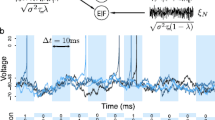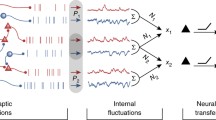Abstract
We consider several measures for the correlation of firing activity among different neurons, based on coincidence counts obtained from simultaneously recorded spike trains. We obtain explicit formulae for the probability distributions of these measures. This allows an exact, quantitative assessment of significance levels, and thus a comparison of data obtained in different experimental paradigms. In particular it is possible to compare stimulus-locked, and therefore time dependent correlations for different stimuli and also for different times relative to stimulus onset. This allows to separate purely stimulus-induced correlation from intrinsic interneuronal correlation. It further allows investigation of the dynamic characteristics of the interneuronal correlation. For the display of significance levels or the corresponding probabilities we propose a logarithmic measure, called “surprise”.
Similar content being viewed by others
References
Abeles M (1982) Local cortical circuits. Studies of brain function, vol 6. Springer, Berlin Heidelberg New York
Aertsen AMHJ, Gerstein GL (1985) Evaluation of neuronal connectivity: sensitivity of cross correlation. Brain Res 340:341–354
Aertsen A, Bonhoeffer T, Krüger J (1987) Coherent activity in neuronal populations: analysis and interpretation. In: Caianiello ER (ed) Physics of cognitive processes. World Scientific Publishing, Singapore, pp 1–34
Aertsen AMHJ, Gerstein GL, Habib M, Palm G et al. (1988) Dynamics of neuronal firing correlation: modulation of “effective connectivity” (submitted for publication)
Billingsley P (1965) Ergodic theory and information. Wiley, New York
Boltzmann L (1887) Über die mechanischen Analogien des zweiten Hauptsatzes der Thermodynamik. J Reine Angew Math 100:201–212
Boogaard H van den, Hesselmans G, Johannesma P (1986) System identification based on point processes and correlation densities. I. The nonrefractory neuron model. Math Biosci 80:143–171
Gerstein G (1987) Information flow and state in cortical neural networks: interpreting multi-neuron experiments. In: Seelen W von, Shaw G, Leinhos U (eds) Organization of neural networks: structures and models. VCH Verlagsgesellschaft, Weinheim, pp 53–75
Gerstein GL, Perkel DH (1969) Simultaneously recorded trains of action potentials: analysis and functional interpretation. Science 164:828–830
Gerstein GL, Perkel DH (1972) Mutual temporal relationships among neuronal spike trains. Biophys J 12:453–473
Gerstein G, Bloom M, Espinosa I, Evanczuk S, Turner M (1983) Design of a laboratory for multi-neuron studies. IEEE Trans SMC-13:668–676
Gerstein GL, Aertsen AMHJ et al. (1988) Neuronal assemblies as observed in multi-neuron experiments: dynamic organization depending on stimulus (in preparation)
Glaser EM, Ruchkin DS (1976) Principles of neurobiological signal analysis. Academic Press, New York
Grinvald A (1985) Real-time optical mapping of neuronal activity: from single growth cones to the intact mammalian brain. Ann Rev Neurosci 8:263–305
Habib MK, Sen PK (1985) Non-stationary stochastic pointprocess models in neurophysiology with applications to learning. In: Sen PK (ed) Biostatistics: statistics in biomedical, public health and environmental sciences. Elsevier/North-Holland, Amsterdam, pp 481–509
Krüger J (1982) A 12-fold microelectrode for recording from vertically aligned cortical neurons. J Neurosci Methods 6:347–350
Krüger J (1983) Simultaneous individual recordings from many cerebral neurons: techniques and results. Rev Physiol Biochem Pharmacol 98:177–233
Kuznetsov PI, Stratonovich RL (1956) A note on the mathematical theory of correlated random points. Izv Akad Nauk SSSR Ser Math 20:167–178; also in: Kuznetsov PI, Stratonovich RL, Tikhonov VI (eds) (1965) Nonlinear transformations of stochastic processes. Pergamon Press, New York, pp 101–115
Legéndy CR (1975) Three principles of brain function and structure. Int J Neurosci 6:237–254
Legéndy CR, Salcman M (1985) Bursts and recurrences of bursts in the spike trains of spontaneously active striate cortex neurons. J Neurophys 53:926–939
Palm G (1981) Evidence, information, and surprise. Biol Cybern 42:57–68
Palm G (1988) Information theory. MIT Press, Cambridge, Mass (in press)
Perkel DH, Gerstein GL, Moore GP (1967) Neuronal spike trains and stochastic point processes. II. Simultaneous spike trains. Biophys J 7:419–440
Perkel DH, Gerstein GL, Smith MS, Tatton WG (1975) Nerveimpulse patterns: a quantitative display technique for three neurons. Brain Res 100:271–296
Shannon C (1948) A mathematical theory of communication. Bell Syst Techn J 27:379–423, 623–656
Author information
Authors and Affiliations
Rights and permissions
About this article
Cite this article
Palm, G., Aertsen, A.M.H.J. & Gerstein, G.L. On the significance of correlations among neuronal spike trains. Biol. Cybern. 59, 1–11 (1988). https://doi.org/10.1007/BF00336885
Received:
Issue Date:
DOI: https://doi.org/10.1007/BF00336885




